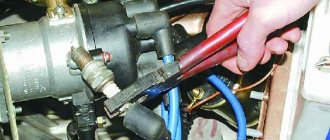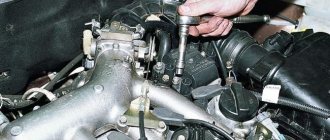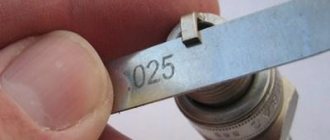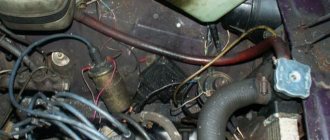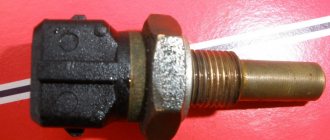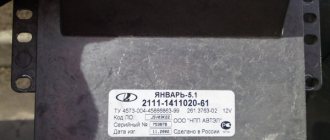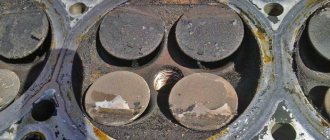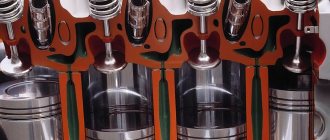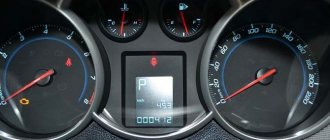Priora won't start, starter turns
| Possible malfunction | Diagnostics | Remedies |
| There is no gasoline in the tank | On the instrument panel the fuel level indicator is at zero. | Pour gasoline |
| Battery is low | The voltage at the battery terminals without load is less than 12V. When trying to start the car, a crashing sound is heard from under the hood. | Charge the battery or replace it with a new one |
| Oxidation of battery terminals or wire terminals, their fit is not tight | When you try to start the engine, the voltage in the on-board network drops much more than at the battery terminals. In this case, a crash may be heard under the hood. | Clean the contacts, lubricate them with petroleum jelly and tighten the terminals |
| Unreliable connection of electrical circuits of engine control and power supply systems | Check the connections of the connectors and the reliability of the contacts in the blocks. | Fix faulty wire connections |
| Increased resistance to rotation of the crankshaft (scores on the shafts, bearing shells, cylinder-piston parts, deformation of the shafts, frozen engine oil, jammed generator, jammed coolant pump) | The crankshaft turns slowly. If the engine is started in severe frost, and the engine was working properly the day before, then most likely the engine oil has frozen. If you hear extraneous noise when starting the engine, check the free rotation of the pump and generator pulleys. | Use the recommended engine oil. Repair the engine. Replace the pump and generator. |
| Malfunction in the ignition system | Check for spark. | Check the circuits and devices of the ignition system. Replace faulty system elements. |
| The high voltage wires are connected in the wrong order or the wire is disconnected | Inspect. | Connect the wires in the correct order |
| The timing belt is broken or the belt teeth are cut off | Open the front timing cover and check. | Replace timing belt |
| Disturbed valve timing | Check the marks on the crankshaft and camshaft pulleys. | Set the correct shaft position |
| Malfunction of the computer (brains), its circuits, crankshaft position sensor or coolant temperature | Check the supply of +12V to the ECU, the sensor circuit, and the absence of damage to the sensors themselves. | Replace ECU, sensors. |
| The idle air regulator (IAC) or its circuits are faulty | Check the idle air control. When starting the engine, lightly press the gas pedal. If the engine starts and stalls when you release the gas pedal, the sensor is faulty. | Replace sensor |
| The fuse is blown or the main relay of the control system is faulty | Check fuse and relay. | Eliminate the cause of the blown fuse. Replace fuse and relay |
| Fuse blown, fuel pump relay. Circuit, relay or pump is faulty. | When the ignition is turned on, there is no sound of the pump running. Check the fuse. Apply voltage to the pump from the battery. | Clean contacts, replace faulty circuits, replace fuse, pump and relay. |
| The fuel filter is dirty, the water in the fuel line is frozen, the fuel line is damaged | Check the pressure in the fuel rail and the condition of the fuel lines. | Replace the filter, blow out or replace the fuel lines. |
| Insufficient pressure in the fuel rail | Check the pressure in the fuel rail, the pump strainer and the condition of the fuel lines. | Clean the filter. Replace pump, fuel pressure regulator |
| Faulty injectors or their power supply circuits | Check the injector windings with an ohmmeter. Check the chains for breaks. | Replace injectors, replace chains |
| Air leak into the intake tract | Inspect the joints and fittings of the hoses and clamps. During start-up, turn off the vacuum brake booster and plug the receiver fitting. | Eliminate air leaks, replace vacuum booster |
Why Lada Priora does not start, causes of malfunctions
- January 15, 2015 Lada.Online 264 215 To start the engine, you need to ensure that a spark appears at a certain moment to ignite the air-fuel mixture in the cylinders. Problems with starting the engine occur if one or more elements of the system malfunction. The table lists possible reasons why the Priora does not start.
If the Lada Priora's starter does not turn
Possible malfunction Diagnostics Remedies
| Low battery | The voltage at the battery terminals without load is less than 12V. When trying to start the engine, a cracking noise is heard from under the hood. | Charge the battery or replace it with a new one |
| Oxidation of battery terminals or wire terminals, their fit is not tight | When you try to start the car, the voltage in the on-board network drops much more than at the battery terminals. In this case, a crash may be heard under the hood. | Clean the contacts, lubricate them with petroleum jelly and tighten the terminals |
| The engine or attachments are jammed | Check the rotation of the crankshaft, pump and generator pulley. | Repair engine, generator, pump |
| The starter is faulty, the starter drive gear or flywheel ring teeth are damaged | Remove and inspect the starter. | Repair or replace starter |
| The starter switching circuit or starter relay is faulty, the wires are damaged, or the ignition switch contacts do not close | When the key is turned to position “II”, the starter traction relay does not operate (a click is not heard under the hood). Check the +12V supply to the control contact of the traction relay. | Replace starter relay, wires, ignition switch |
| The starter traction relay is faulty, there is a short circuit or break in the retractor winding, the relay armature is stuck | When the key is turned to position “II”, the traction relay does not operate (there is no click under the hood), but + 12V is supplied to the control contact of the traction relay. Remove the relay and check its operation. | Replace the traction relay |
| Contacts or wires of the traction relay are oxidized, poor ground contact | When the starter is turned on, a clicking sound is heard under the hood, but the starter armature does not rotate. Using an ohmmeter, check the resistance of the Battery-Starter circuit, as well as the ground wire. If the circuit is in good condition, remove the starter and check the operation of the traction relay by applying +12V to it from the battery | Tighten the terminals, clean the contacts, replace the traction relay |
| Open or short circuit in the holding winding of the traction relay | When you try to start the engine, you hear a crashing sound under the hood. The battery voltage is within normal limits. We check the traction relay with an ohmmeter or by its excessive heating. | Replace the traction relay |
| Burning of the starter commutator, sticking of the brushes or their severe wear; Break or short circuit in the starter armature winding | The starter armature rotates slowly or does not rotate at all. Check the traction relay by applying voltage to the starter contact bolt directly from the battery | Replace starter or armature |
| Freewheel slipping | When the starter is turned on, the armature rotates, the flywheel is stationary | Replace clutch or starter |
Priora won't start, starter turns
Possible malfunction Diagnostics Remedies
| There is no gasoline in the tank | On the instrument panel the fuel level indicator is at zero. | Pour gasoline |
| Battery is low | The voltage at the battery terminals without load is less than 12V. When trying to start the car, a crashing sound is heard from under the hood. | Charge the battery or replace it with a new one |
| Oxidation of battery terminals or wire terminals, their fit is not tight | When you try to start the engine, the voltage in the on-board network drops much more than at the battery terminals. In this case, a crash may be heard under the hood. | Clean the contacts, lubricate them with petroleum jelly and tighten the terminals |
| Unreliable connection of electrical circuits of engine control and power supply systems | Check the connections of the connectors and the reliability of the contacts in the blocks. | Fix faulty wire connections |
| Increased resistance to rotation of the crankshaft (scores on the shafts, bearing shells, cylinder-piston parts, deformation of the shafts, frozen engine oil, jammed generator, jammed coolant pump) | The crankshaft turns slowly. If the engine is started in severe frost, and the engine was working properly the day before, then most likely the engine oil has frozen. If you hear extraneous noise when starting the engine, check the free rotation of the pump and generator pulleys. | Use the recommended engine oil. Repair the engine. Replace the pump and generator. |
| Malfunction in the ignition system | Check for spark. | Check the circuits and devices of the ignition system. Replace faulty system elements. |
| The high voltage wires are connected in the wrong order or the wire is disconnected | Inspect. | Connect the wires in the correct order |
| The timing belt is broken or the belt teeth are cut off | Open the front timing cover and check. | Replace timing belt |
| Disturbed valve timing | Check the marks on the crankshaft and camshaft pulleys. | Set the correct shaft position |
| Malfunction of the computer (brains), its circuits, crankshaft position sensor or coolant temperature | Check the supply of +12V to the ECU, the sensor circuit, and the absence of damage to the sensors themselves. | Replace ECU, sensors. |
| The idle air regulator (IAC) or its circuits are faulty | Check the idle air control. When starting the engine, lightly press the gas pedal. If the engine starts and stalls when you release the gas pedal, the sensor is faulty. | Replace sensor |
| The fuse is blown or the main relay of the control system is faulty | Check fuse and relay. | Eliminate the cause of the blown fuse. Replace fuse and relay |
| Fuse blown, fuel pump relay. Circuit, relay or pump is faulty. | When the ignition is turned on, there is no sound of the pump running. Check the fuse. Apply voltage to the pump from the battery. | Clean contacts, replace faulty circuits, replace fuse, pump and relay. |
| The fuel filter is dirty, the water in the fuel line is frozen, the fuel line is damaged | Check the pressure in the fuel rail and the condition of the fuel lines. | Replace the filter, blow out or replace the fuel lines. |
| Insufficient pressure in the fuel rail | Check the pressure in the fuel rail, the pump strainer and the condition of the fuel lines. | Clean the filter. Replace pump, fuel pressure regulator |
| Faulty injectors or their power supply circuits | Check the injector windings with an ohmmeter. Check the chains for breaks. | Replace injectors, replace chains |
| Air leak into the intake tract | Inspect the joints and fittings of the hoses and clamps. During start-up, turn off the vacuum brake booster and plug the receiver fitting. | Eliminate air leaks, replace vacuum booster |
Reasons why Priora starts and stalls
- Ignition coil electrical connections are loose or damaged.
- Insufficient pressure in the fuel rail.
- The connections of the intake tract parts are leaking (catalytic manifold or intake manifold receiver).
- The engine control system is faulty. Run diagnostics.
Lada Priora does not start when cold
- If the crankshaft rotates slowly, the battery may be discharged or the engine oil may be frozen.
- The vehicle's fuel system is faulty. The water in the ramp may have frozen.
- The coolant temperature sensor (DTOZH) of the engine management system is faulty.
- Fuel injectors are leaking.
- Low compression in cylinders.
- The engine control system is faulty. Run diagnostics.
If the Lada Priora does not start well when cold
- Pay attention to the quality of the fuel; there may be a lot of water accumulated in the gasoline.
- Check the ignition module, as well as the serviceability of high-voltage wires and spark plugs.
- Check the oxygen sensor.
If the Priora does not start well when hot
In this case, see the second table; in addition to the reasons described, also pay attention to:
- A pressure regulator that can discharge fuel through a membrane into the receiver.
- DPKV contacts, if the sensor has been changed, check that the poles are connected correctly.
- Faulty ignition module.
Let us remind you that in some cases the Priora does not start due to a faulty immobilizer or alarm system. In some cases, reflashing the engine ECU (electronic control unit) helps solve the problem of poor starting. And regular car maintenance will help eliminate problems of poor engine starting. Keywords: Lada Priora engine | ignition system for Lada Priora | starter Lada Priora | power supply system for Lada Priora | ECM Lada Priora 14 1 Found an error? Select it and press Ctrl+Enter..
Source: https://lada.online/do-my-self/repair/repair-lada-priora/217-pochemu-ne-zavoditsya-lada-priora-prichiny-neispravnostey.html
If the Priora does not start well when hot
In this case, see the second table; in addition to the reasons described, also pay attention to:
- A pressure regulator that can discharge fuel through a membrane into the receiver.
- DPKV contacts, if the sensor has been changed, check that the poles are connected correctly.
- Faulty ignition module.
Let us remind you that in some cases the Priora does not start due to a faulty immobilizer or alarm system. In some cases, reflashing the engine ECU (electronic control unit) helps solve the problem of poor starting. And regular car maintenance will help eliminate problems of poor engine starting.
No spark on Priora 16 valve reasons
1. The crankshaft sensor has working power. +12V 2. The coils are working and there is power to them. +12v 3. ECU computer working. 4. the starter turns. 5. the pump pumps. 6. The belt is intact. what kind of HZ. ? what could it be?
I can also give an answer like “for service.” I can also give such an answer. on the service they don’t say don’t ask a lot of questions, go to “mail ru answers”, sorry for such rudeness, there are those who answer anyway. Thank you for your attention and thanks in advance for your answer.
There is no spark and the pump does not turn on. I changed one fuse, under the passenger's feet.
- The engine stalls immediately after starting on a VAZ Priora - 7 answers
- At an air temperature of -15, the engine does not start, VAZ Priora – 5 answers
- Priora starts and stalls when cold - 4 answers
- Stalls after starting Priora - 4 answers
- Lada Priora starter does not turn - 3 answers
Does the starter seem to be turning? When there is no spark, the DPKV may be faulty. But it’s strange that the fuel pump doesn’t work; it should start working when the ignition is turned on. What fuse did you replace there and why?
Here's about the fuse and relay block of the Lada Priora VAZ-2170, 2171, 2172, maybe check where the contact is loose.
Many car enthusiasts have encountered the loss of spark on the 16-valve VAZ-2112 engine. What is this defect associated with? The first thing that suggests itself is the ignition. But, in this case, not everything is so simple, since the problem may lie deeper than it seems at first glance.
The video describes a situation when you lose a spark on the road and the car does not start:
The 16-valve VAZ-2110 has no spark
Obvious reasons include malfunctions of the ignition coil, spark plugs, fuel pump, high-voltage wires and gas distribution mechanism.
Troubleshooting is carried out similarly to an 8-valve car. Candles are the first stage of testing. A visual inspection will help find flaws, after which they resort to checking the gaps and measuring the resistance.
Proven method: unscrew the spark plug, put on a high-voltage wire, install the base on the engine or body. After cranking the starter, a spark should form. Safety regulations must be followed.
Another reason may be hidden in the timing belt, namely, if the valve timing has gone astray due to improper installation of the timing disk. It is located on the crankshaft pulley and acts as a synchronizer.
It is quite possible to correct the situation if you change the installation of disks in accordance with the applied marks. The easiest way to find shortcomings is in working with high-voltage wires. However, it is necessary to understand that the engine will operate in strong vibration mode.
What could be the reason:
- The wire doesn't work. A complete replacement helps.
- Incorrect connection. Change the connection location.
The main reasons for the lack of spark
General view of the engine 10-12 series 16 valves
Not all motorists know the reasons for the loss of spark, much less methods for diagnosing and troubleshooting problems. So, it is worth identifying the main reasons, and then deciphering why exactly they become the cause. Finally, you need to consider ways to eliminate the defect. So, what reasons could cause the spark to disappear:
conclusions
Loss of spark on a 16-valve VAZ-2112 may be a consequence of the failure of several vehicle components at once or each individually. But, if the operations indicated in the article did not help, then you should contact specialists at a car service center who will accurately identify the cause and eliminate it.
It is unlikely that several nodes will fail at once. This has not happened in my practice. Unless, of course, you hit the car properly.
The ignition coil rarely fails because it is initially reliable. But the spark plugs and fuel pump often fail.
Even if the timing phase is off, there should be a spark!
There will be a spark, but not at the right time when the air-fuel mixture arrives.
the article sucks. wrote the teapot. Moreover, the pump and the spark, and the timing belt. even with a broken timing belt there will be a spark. Kettle...boil somewhere else
What does the fuel pump and broken phases have to do with it? The author is in the furnace.
Wrote 100% who themselves have no idea what they are writing, if on the 12th engine if the spark disappears completely, then 80% is the module, and then 5% each of the crankshaft sensor, ignition switch, ECU and a break in the bus from the brain to the module or crankshaft all
Oh yes, I almost forgot the immobilizer and the signaling may be glitchy
I have a VAZ 2110 2001. First, the fuel pump failed, I found and eliminated the cause; the spark disappeared from the fuel pump; I can’t find the cause yet.
Still haven't found the spark?
I have the same problem. What helped in the end?
Guys, such garbage, no spark, no prior, crankshaft sensor called, coils too, they put another prior on mine and vice versa, I tried everything and it’s not there??
You write specifically for not all kinds of bullshit.
but there is a spark from the central one, that is, it goes to the distributor, but from the spark plug... oops! Everything was replaced with new ones, BREMI, and it’s still there!
Hello everyone, I have a 2112 16 valve, I turn the starter on the dashboard, all the lower indicators are blinking and the relay is knocking on the right side at the bottom, the car won’t start, I checked the spark and it hits every other time, can the module show off like that?
Exactly the same problem. Didn't find a solution?
Charge the battery, everything will be fine
VAZ 21124 1.6 16kl engine 124 The cylinder head gasket in the 4th cylinder was broken. I dismantled it, cleaned everything, washed it properly, ground the valve, changed the gasket and reassembled it, and now, disappointingly, the engine does not start, there is a spark, there is also fuel. Ignition is normal. The motor sat disassembled for a month. Having rummaged around on your website, I found the reason for the installation, due to inattention, I mixed up the camshafts. Because of my carelessness, I had to re-open the engine and, as it turned out, the truth justified itself. I swapped the camshafts, fortunately the valves on my engine don’t bend. I cleaned the old sealant, degreased it, applied a new one, and assembled everything in the reverse order. And as a result, the engine also does not start, I was upset about my work, it seemed like I was doing everything according to the instructions. This time the reason was the lack of fuel and spark. I racked my brain and checked everything several times but to no avail. I had to resort to this site again, and still found the reason, I started the engine with an uninstalled generator drive pulley. Eliminated the cause, everything was fine, the engine started, everything is normal, thanks for the information
No spark in the first cylinder
If the spark is lost on a VAZ 2112 injector 16 valves, then you can diagnose the breakdown using a spark gap made by yourself. The drawing shows a diagram for checking the presence of a spark simultaneously for 4 conductors,
and the photo shows a device for testing 2 wires.
Having installed the spark plugs in the spark gap, you need to turn on the ignition and observe the occurrence of an electric arc. If it appears on only one of the two spark plugs when the current is distributed simultaneously to 2 spark plugs, this indicates that the conductors or windings of the ignition module have been pierced to ground. If there is no spark on two spark plugs at the same time, the cause should be found in a malfunction of the controller or ignition winding. It is quite possible that this is caused by a broken wire.
To determine the integrity of all electrical cables, their resistance is measured - as a rule, it should be identical in all wires of one electrical circuit. Check the serviceability of the coils using controller diagnostics for errors. If the module cannot be verified, then it is better to simply replace it with a new one (or a used one, but in good working order) and repeat the check again. In the case when there is still no spark on the VAZ 2110 injector 8 valves, you need to diagnose the controller and the electrical wiring connecting it to the coil.
If there is no current in all cables, you need to check the power supply to the coil and the presence of a minus. If the wires turn out to be in good condition, then it is necessary to check the functionality of the sensor responsible for the location of the crankshaft. This must be done as follows. Turn off the ignition and the fuel pump stops working. Now, if we start cranking the crankshaft and the pump turns on, then the sensor is in working condition. However, it should be remembered that some models of controllers turn on the pump only when a certain crankshaft speed is reached.
If the spark on the VAZ 2110 injector is lost due to a controller malfunction, then in most cases this is caused by a breakdown of the transistor. For this reason, modules also fail. If the module is in compound, the controller must be repaired. To carry it out, basic electrical skills and the ability to use a soldering iron are enough, so you can do it yourself. The sensor breaks very rarely, and if there is no spark in the VAZ 2114 injector, then most likely the contact in the sensor’s power supply is simply broken.
This may be caused by dirt, oil, or improper installation of electrical wiring after repairs. If after cleaning all the connecting elements the problem does not disappear, proceed to more specific diagnostics.
https://emex52.ru
How to fix the problem
Five reasons why the heater in the car does not heat up
So, the reason why the spark disappeared has been established. Now you can move on to fixing the problem. If it's all about the ignition coil, then checking with a multimeter will show this. One point should be noted here. If the ignition coil is faulty, then it is best to immediately replace it with a new one. Some people decide to repair this unit on their own, but practice has already proven that this is nothing more than a temporary measure. The result will still be the same - replacing the damaged ignition coil.
The cause may also be a malfunction of the fuel pump. Checking here starts with the simplest. You should turn on the ignition and listen to see if fuel pumping has begun. If the operation of the fuel pump is not heard, you need to check whether fuel is getting into the cylinders. Also inspect the fuse for the fuel pump for integrity. If it fails, replace it.
The reason may be directly in the fuel pump itself. In order to find it, you will need to remove the entire module and disassemble it. It is quite easy to check the performance of the pump. To do this, you need to close the contacts through the tester. In the absence of any indicators, the “death of the patient” can be stated. In such a situation, the part must be replaced with a new one. If “the patient is alive,” then you should check the wiring for breaks and clean the contact group.
Another fairly common reason is candles. To make a more accurate diagnosis, we unscrew them one by one and conduct a visual inspection. If nothing like this is found, we proceed to checking the gap and measuring the resistance. You can check the performance of spark plugs on a special stand, but this is unlikely to be in the garage of most motorists.
Therefore, you will have to use the old, time-tested method. We put a high-voltage wire on the previously unscrewed spark plug, and install its base on ground - the car body or engine. Checking for the presence of a spark is carried out when the starter is cranked
It should be noted that it is important to be especially careful with this verification method. It’s best to simply ask one of your neighbors in the garage for a known working kit of a suitable size - this method of checking will be safer
Problems in the operation of the gas distribution mechanism can also cause a lack of spark. However, the timing belt is the last place where you should look for the source of the malfunction. However, sometimes the problem lies in misaligned valve timing due to incorrect installation of the timing disk. It is located on the crankshaft pulley and plays the role of a synchronizer for the sensor. In order to fix the problem, you must install the disk correctly in accordance with the marked marks.
It is quite easy to detect the cause of problems with high-voltage wires. In this case, the engine will stall, and this will manifest itself as noticeable vibration during operation of the power unit. There are two options here - either the wire is faulty, or they are connected incorrectly. In the first case, it is best to change the entire set at once, in the second, rearrange them in the correct sequence.
Note that not all the reasons why the spark on a VAZ-2110 can fail are given here. The problem may arise, for example, with the controller or with a broken wiring. Sometimes it lies on the surface, and in some cases you have to work hard to detect the malfunction. If you are not particularly knowledgeable about the structure of a car, it is best to immediately seek help from a specialist. This option has one main advantage. Diagnostics will not cost that much, but at the same time you will save your time by not wasting it on a lengthy search for the reasons for the lack of a spark.
Why the spark disappears - main reasons
Spark plugs VAZ 2114 injector 8 valves price
On different types of engines, there is a fairly wide list of reasons why there is no spark at the spark plugs. Among the main experts are:
- Problems with spark plugs (destruction of the spark plug body, defects in the electrodes, etc.). It is also worth noting that the spark plugs may be filled with fuel or oil, which indicates a breakdown of the engine itself.
- Malfunctions of high-voltage wires associated with insulation breakdown or lack of contact.
- Failure or errors in the operation of the crankshaft position sensor.
- Problems with the ignition module, ignition coil, switch;
- Malfunctions or malfunctions of the distributor.
- Deterioration or absence of ground contact.
- Errors related to the operation of the electronic engine control unit (ECU);
conclusions
How to check the crankshaft sensor of a VAZ 2115 injector 8 valves
Loss of spark on a 16-valve VAZ-2112 may be a consequence of the failure of several vehicle components at once or each individually. But, if the operations indicated in the article did not help, then you should contact specialists at a car service center who will accurately identify the cause and eliminate it.
It is unlikely that several nodes will fail at once. This has not happened in my practice. Unless, of course, you hit the car properly.
The ignition coil rarely fails because it is initially reliable. But the spark plugs and fuel pump often fail.
Even if the timing phase is off, there should be a spark!
There will be a spark, but not at the right time when the air-fuel mixture arrives.
the article sucks. wrote the teapot. Moreover, the pump and the spark, and the timing belt. even with a broken timing belt there will be a spark. Kettle...boil somewhere else
What does the fuel pump and broken phases have to do with it? The author is in the furnace.
Wrote 100% who themselves have no idea what they are writing, if on the 12th engine if the spark disappears completely, then 80% is the module, and then 5% each of the crankshaft sensor, ignition switch, ECU and a break in the bus from the brain to the module or crankshaft all
Oh yes, I almost forgot the immobilizer and the signaling may be glitchy
I have a VAZ 2110 2001. First, the fuel pump failed, I found and eliminated the cause; the spark disappeared from the fuel pump; I can’t find the cause yet.
Still haven't found the spark?
I have the same problem. What helped in the end?
Guys, such garbage, no spark, no prior, crankshaft sensor called, coils too, they put another prior on mine and vice versa, I tried everything and it’s not there??
You write specifically for not all kinds of bullshit.
but there is a spark from the central one, that is, it goes to the distributor, but from the spark plug... oops! Everything was replaced with new ones, BREMI, and it’s still there!
Hello everyone, I have a 2112 16 valve, I turn the starter on the dashboard, all the lower indicators are blinking and the relay is knocking on the right side at the bottom, the car won’t start, I checked the spark and it hits every other time, can the module show off like that?
Exactly the same problem. Didn't find a solution?
Charge the battery, everything will be fine
VAZ 21124 1.6 16kl engine 124 The cylinder head gasket in the 4th cylinder was broken. I dismantled it, cleaned everything, washed it properly, ground the valve, changed the gasket and reassembled it, and now, disappointingly, the engine does not start, there is a spark, there is also fuel. Ignition is normal. The motor sat disassembled for a month. Having rummaged around on your website, I found the reason for the installation, due to inattention, I mixed up the camshafts. Because of my carelessness, I had to re-open the engine and, as it turned out, the truth justified itself.
I swapped the camshafts, fortunately the valves on my engine don’t bend. I cleaned the old sealant, degreased it, applied a new one, and assembled everything in the reverse order. And as a result, the engine also does not start, I was upset about my work, it seemed like I was doing everything according to the instructions. This time the reason was the lack of fuel and spark. I racked my brain and checked everything several times but to no avail. I had to resort to this site again, and still found the reason, I started the engine with an uninstalled generator drive pulley.
Eliminated the cause, everything was fine, the engine started, everything is normal, thanks for the information
Source: https://7gear.ru/tuning/vaz-2112-net-iskry.html
Ignition system
Such a system is a collection of parts that are involved in the process of spark formation in the engine. A spark in an internal combustion engine is necessary to ignite the fuel mixture in the combustion chamber. If the engine loses spark, its operation stops completely.
The Priora ignition system includes the following elements:
- Ignition coil;
- Spark plug;
- Crankshaft position sensor;
These three parts are responsible for the formation of a spark in the Priora engine; failure of one of them entails the loss of spark in a particular cylinder.
Let's look at each part of the car's ignition system in more detail to understand their purpose in more detail.
Spark plug
Spark plugs are used in all gasoline-powered vehicles. It screws into the cylinder head and creates a spark in the combustion chamber, which is necessary to ignite the fuel mixture.
The spark plug is a part with a threaded part that is screwed into the cylinder head; an electrode is placed inside the threaded part that generates a spark. Since the spark plug operates under high voltage, a special insulator is used in the spark plug to prevent breakdown and leakage of voltage.
Ignition coil
As described above, the Priora already uses an individual ignition coil. Such a coil is installed on each cylinder and is responsible for supplying a spark to a specific cylinder. The transition to IKZ made it possible to increase engine power while saving fuel.
The ignition coil is a part in which there are two windings, primary and secondary. A voltage of 12V is supplied to the primary winding, and a voltage of almost 40,000 Volts is generated on the secondary winding. This voltage is necessary for reliable spark formation in the combustion chamber.
Crankshaft position sensor
This sensor is necessary to determine the top dead center of the internal combustion engine, that is, when the compression stroke occurs in the engine, it is necessary to supply a spark in the combustion chamber. This sensor understands when the piston is at the top and sends a signal to the ECU, which in turn sends a signal to the IKZ to form a spark in this cylinder. This is how the fuel-air mixture ignites in a specific cylinder.
This sensor is installed next to the crankshaft pulley and reads readings from it. There are marks on the crankshaft pulley that the DPKV reads and thereby determines TDC.
It should be noted that a breakdown of this sensor or a break in its power supply leads to a loss of spark in the internal combustion engine and the inability to start it.
Misfires on Priora
There may be no spark at the Prior due to a breakdown of the sensor, coil, spark plug or ECU. Failures that lead to loss of spark are quite easy to solve, with the exception of a breakdown in the ECU.
If the spark on a Priora disappears on all 4 cylinders, this indicates a breakdown of the crankshaft sensor in 80% of cases, in the remaining 20% the ECU may fail.
If there is no spark on one of the cylinders, then there may be several reasons - a spark plug, a coil or a transistor in the ECU.
Consider each of the reasons in more detail.
Spark plug
Quite often, low-quality spark plugs can fail after several hundred kilometers or even immediately after installation. It is recommended to purchase only high-quality spark plugs.
Which spark plugs are best for Priora can be read in our article.
You can check the serviceability of the spark plug on a special stand or by trying to replace it with a new one or by installing a suspicious spark plug in the working cylinder.
Ignition coil
Problems with the coil appear practically the same as with spark plugs. One of the windings in it may break or break through the insulation, which causes the coil to malfunction. IKZ Prioras cannot be repaired and if they break down they are replaced with a new one.
You can check the serviceability of the coil by replacing it with a coil of another cylinder or using a special diagnostic device ELM 327.
You can read how to check the coil here.
Crankshaft position sensor
DPKV is installed in a place that is subject to both mechanical and temperature influences. Since the sensor works on the principle of a magnet, and its sensitive part tends to magnetize chips. The formation of chips on the sensor will negatively affect the reading from the crankshaft pulley, which can lead to the inability to determine TDC and, consequently, to loss of spark.
The sensor's power circuit is located close to the exhaust manifold, which heats up to enormous temperatures. Because of this, the DPKV wiring is exposed to high temperatures, which leads to the destruction of the insulation and screen of the wire, and this has a bad effect on the transmission of information to the ECU and can cause a loss of spark.
There is no spark, we check the functionality of the components. Algorithm for finding a spark on spark plugs and ignition coil
When the spark is lost, you will, of course, never start the car, and in such a situation, first of all, you need to check the ignition system.
The vehicle's ignition system plays a key role in its operation. If in case of many other malfunctions the car can be taken under its own power to the service station, then in case of problems with the ignition it is unlikely that it will be possible to start the engine at all.
How to check the spark
Checking the spark on a spark plug can be done in several ways:
- Check for ground (the spark plug body is pressed against the engine and the spark is analyzed when the starter rotates).
- Checking the spark plug with a multimeter (you can determine the breakdown of the spark plug).
- Diagnostics with a tester based on a piezoelectric element (the testing principle is similar to the ground breakdown method; the presence of a spark is determined and is used mainly on fuel-injected cars).
The main reasons why there is no spark
- problem with spark plugs (flooded or faulty);
- breakdown of high-voltage wires or loss of contact;
- the reason is the crankshaft sensor (requires checking with a multimeter);
- malfunction in the ignition module;
- failure of the ignition coil;
- problem in the switch;
- Distributor malfunction (burned contacts, loss of clearance);
- poor ground wire contact;
- failure or malfunction of the ECU;
No spark injector
You need to be very careful when checking the spark on fuel-injected cars (especially for foreign cars - you can burn the electronic unit).
It is recommended to use a spark gap to understand at what stage there is no spark on the spark plugs (no spark from the distributor, no spark from the coil, or directly from the spark plug itself). If there is no spark in all cylinders at the same time, there may be several culprits:
- controller;
- entire module;
- coil or center wire.
The entire checking procedure should begin with the integrity of the fuses, the condition of the ground contacts and contacts on high-voltage wires.
If there is no spark from the ignition coil, then the reason may be hidden in many places. First of all, you need to check the high voltage wire, which must be in perfect condition and without damage to the insulation. Otherwise, the wire needs to be replaced.
No spark, check spark plugs
If the problem is not solved, then check the spark plugs. The spark plug contacts must be clean. The fact that there is no spark may be caused by dirty spark plug contacts. It is best to replace the spark plugs, but you can also clean the contacts. But before changing the spark plugs, check whether the discharge reaches the spark plugs themselves.
To do this, remove the spark plug wire and bring it to the car body at a distance of 0.5 cm. Turn the starter several times and see if there is a spark between the wire and the body. The spark should be white with a slight blue tint.
If it is absent or present, but with a different shade, we can say that the spark plugs are fine, and the problem is in the heart of the car’s ignition system - the coil.
How to check spark on ignition coil
To see if the coil is working at all, pull the wire from the breaker distributor that comes from the coil. The same test is carried out with it as with the spark plug wires, namely, they bring the wire to a distance of 0.5 cm and turn the starter. Now, regardless of the result, we can accurately talk about the cause of the breakdown.
If there is a spark, then the problem is in the distributor-chopper; if there is no spark, then the ignition coil is faulty.
In the first case, you need to check the contacts in the distributor-breaker for oxidation, insulation damage, and also check the serviceability of the rotor. If there is no spark due to it, the rotor must be replaced.
Checking the ignition coil
Checking the ignition coil also involves inspecting the integrity of the windings for physical damage, as well as burnt spots, which indicate a short circuit in the coil. In these cases, the coil either needs to be repaired or replaced.
The spark disappeared on the 16-valve VAZ-2112 injector: causes and diagnostics
Many car enthusiasts have encountered the loss of spark on the 16-valve VAZ-2112 engine. What is this defect associated with? The first thing that suggests itself is the ignition. But, in this case, not everything is so simple, since the problem may lie deeper than it seems at first glance.
The video describes a situation when you lose a spark on the road and the car does not start:
Why there is no spark on the VAZ-2112 injector 16 valves: photo and video
Many car enthusiasts have encountered the loss of spark on the 16-valve VAZ-2112 engine. What is this defect associated with? The first thing that suggests itself is the ignition. But, in this case, not everything is so simple, since the problem may lie deeper than it seems at first glance.
The video describes a situation when you lose a spark on the road and the car does not start:
The main reasons for the lack of spark
General view of the engine 10-12 series 16 valves
Not all motorists know the reasons for the loss of spark, much less methods for diagnosing and troubleshooting problems. So, it is worth identifying the main reasons, and then deciphering why exactly they become the cause. Finally, you need to consider ways to eliminate the defect. So, what reasons could cause the spark to disappear:
All the reasons have been found and it is worth moving on to the process of eliminating this malfunction.
Are you giving me a spark? Troubleshooting!
First of all, it’s worth noting that you don’t need to rush to check right away. As practice shows, there is a certain sequence of actions and malfunctions that could lead to loss of spark on a 16-valve engine.
The main reasons for the lack of spark
General view of the engine 10-12 series 16 valves
Not all motorists know the reasons for the loss of spark, much less methods for diagnosing and troubleshooting problems. So, it is worth identifying the main reasons, and then deciphering why exactly they become the cause. Finally, you need to consider ways to eliminate the defect. So, what reasons could cause the spark to disappear:
- Failure of the fuel pump.
- Spark plug.
- Ignition coil.
- High-voltage wires and their location.
- Gas distribution mechanism.
All the reasons have been found and it is worth moving on to the process of eliminating this malfunction.
Are you giving me a spark? Troubleshooting!
First of all, it’s worth noting that you don’t need to rush to check right away. As practice shows, there is a certain sequence of actions and malfunctions that could lead to loss of spark on a 16-valve engine.
Fuel pump
Fuel pump made by Bosch
Ignition is not the first reason for the ignition failure on a car. Before getting into the electrical part of the car, it’s worth delving into the mechanics, so to speak. Turn on the ignition and listen to see if the gasoline pump is working . If it is silent, then you need to check whether gasoline is entering the cylinders.
It is worth starting the diagnostic procedure by checking the fuses for serviceability. Of course, you can only view the one that is responsible for the fuel pump (in this case, when you turn on the ignition, the pump will not pump), but it is recommended to diagnose everything for integrity. If at least one fails, it must be replaced.
The fuses are located to the left of the steering wheel under the light mode switch
If the previous procedure did not help, then we turn directly to the pump itself. For diagnostics, you will have to remove the entire module, which is located under the rear sofa, and disassemble it.
The pump itself is easy to check - the contacts are closed through the tester. If there are no readings, then the part has “died” and requires replacement. If the pump is “live”, then it is necessary to clean the contact group and check the wiring for breaks.
Spark plug
Location of spark plugs on the engine
Lost spark on VAZ 2112 injector 16 valves, reasons, diagnostics
In the VAZ 2110 car, injector errors appear quite often. You can see them on the on-board computer, but special tables are needed to decipher them. After all, the ECU produces errors in the form of codes that consist of the letter P and four numbers. Before you begin to solve the problem that has arisen, you should find out what problems there are in the VAZ car.
VAZ injector errors
Errors can relate to any part of the car:
- Sensors Most often, temperature sensors suffer, as they can overheat too much;
- Injectors. Mostly, problems are observed due to an open circuit, as a result of which they cannot light up in time. This leads to another problem - the spark has disappeared, so the engine does not start;
- Engine. The most common mistake is overheating. Most often, due to increased oiliness, the spark plugs also overheat, so a spark does not appear. As a result, the engine does not emit any signs of life;
- Valves. They can also be too dirty, which will cause them to close, so they will not pass the fuel-air mixture;
- Fans. If they do not work correctly, the machine overheats.
What if the spark is lost?
If the engine does not start, but sounds are made indicating that the fuel pump is working, you should pay attention to the operation of the ignition. First of all, you should check whether the spark has disappeared on the wires with high resistance. To do this, it is necessary to use a spark gap, as well as a Hall sensor, which checks the presence of a magnetic field.
The possibility of breaking high-resistance wires is also not worth it. To do this, you can use a Hall Sensor, which helps measure the current in conductors, as well as their resistance. To check the operation of the ignition coils, you should pay attention to whether there are any error codes on the controller. If there is no spark after replacing the coil, then the controller is faulty.
Testing for spark
If there is an ignition coil on each of the engine cylinders, then testing for the presence of a spark occurs somewhat differently. In this case you will also need a Hall Sensor. If there is no spark on only one coil, then it should be replaced. But if it doesn't appear at all, then the problem is much more complicated. In this case, the problem may be due to a faulty controller or broken wiring.
To more easily test the presence of a spark discharge, it is advisable to use a Hall Sensor.
It must be brought to the faulty coil and turned on. If the arrow starts to rise, it means there is current in the wires.
Common mistakes during diagnostics
Most people, due to ignorance of the VAZ 2110 injector machine, make many mistakes in the process of identifying problems.
Let's look at some of them:
- Many people make a common mistake: when they see that there is no spark, they want to check it for breaks. For this purpose, they place the wire close to the ground of the machine. But when performing such actions, the ignition module may break, so under no circumstances should you do this;
- Another problem is checking the spark discharge. If you place spark plugs on the engine body, a large induction current may appear. This occurs even due to slight contact of the spark plug with the ground, as a result of which the controller can also be damaged. Therefore, it is necessary to use a spark gap that will not allow the distribution of ignition with the same supply of high voltage to two spark plugs at once.
Hall sensor for system diagnostics
A Hall sensor is a device needed to measure the magnetic field, current, and resistance in conductors. Currently, there are two types of such devices: analog and digital. The latter can determine where there is and where there is no magnetic field. That is, it can be used if the spark in the VAZ 2110 injector is lost.
ANALOG HALL SENSOR CONVERTS THE FIELD INDUCTION INTO VOLTAGE.
And the value shown by him completely depends on the polarity of the field, as well as its strength.
Application
The Hall sensor is an integral part of many modern devices. Most often, of course, it is used to measure the voltage of a magnetic field. But it is also used during diagnostics of the ignition systems of VAZ and other cars. The main advantage is that the device has a non-contact effect. Therefore, there is no likelihood that a short circuit will appear in the circuit.
The engine won't start?
If, as a result of the check, it became clear that the spark hits the spark plugs, but the VAZ 2110 injector engine still does not start, then it is also necessary to diagnose it. The faults that cause this problem can be serious or not very serious.
At the same time, it is sometimes possible to cope with their solution without anyone’s help:
- It is necessary to purchase a spark gap and a Hall Sensor, which is inexpensive, but has an irreplaceable purpose. With their help, you can find out about the presence of a spark in the candles;
- Check the spark plugs to see if they are OK. A spark gap can be used for this purpose. However, you need to remember that the controller will be broken if candles are placed on its body;
- Perform fuel pump diagnostics. When you try to start a VAZ 2110 car, a characteristic sound will appear from under the rear seat. If there is no sound, then you need to check the fuses and the main relay. In a VAZ 2110 car they are located behind the side cover of the driver's seat.
If, after diagnostics, problems were identified with one of these elements, then you can fix them yourself. Usually the spark plugs begin to work after proper wiping, although this does not always happen, so they have to be replaced.
If the light is on
Sometimes the injector fault light stays on until the engine warms up to 90 degrees, after which it stops flashing. This is usually observed in winter, when there is severe frost outside. And although the problem is not serious, it will have to be solved. It happens like this:
- Replace the injector sensor;
- Get the firmware installed at a car service center;
- Remove the battery terminals. Perhaps the light came on, but never went out.
- And after removal, the injector will be overloaded.
conclusions
Loss of spark on a 16-valve VAZ-2112 may be a consequence of the failure of several vehicle components at once or each individually. But, if the operations indicated in the article did not help, then you should contact specialists at a car service center who will accurately identify the cause and eliminate it.
It is unlikely that several nodes will fail at once. This has not happened in my practice. Unless, of course, you hit the car properly.
The ignition coil rarely fails because it is initially reliable. But the spark plugs and fuel pump often fail.
Even if the timing phase is off, there should be a spark!
There will be a spark, but not at the right time when the air-fuel mixture arrives.
the article sucks. wrote the teapot. Moreover, the pump and the spark, and the timing belt. even with a broken timing belt there will be a spark. Kettle...boil somewhere else
What does the fuel pump and broken phases have to do with it? The author is in the furnace.
Wrote 100% who themselves have no idea what they are writing, if on the 12th engine if the spark disappears completely, then 80% is the module, and then 5% each of the crankshaft sensor, ignition switch, ECU and a break in the bus from the brain to the module or crankshaft all
Oh yes, I almost forgot the immobilizer and the signaling may be glitchy
I have a VAZ 2110 2001. First, the fuel pump failed, I found and eliminated the cause; the spark disappeared from the fuel pump; I can’t find the cause yet.
Still haven't found the spark?
I have the same problem. What helped in the end?
Guys, such garbage, no spark, no prior, crankshaft sensor called, coils too, they put another prior on mine and vice versa, I tried everything and it’s not there??
You write specifically for not all kinds of bullshit.
but there is a spark from the central one, that is, it goes to the distributor, but from the spark plug... oops! Everything was replaced with new ones, BREMI, and it’s still there!
Hello everyone, I have a 2112 16 valve, I turn the starter on the dashboard, all the lower indicators are blinking and the relay is knocking on the right side at the bottom, the car won’t start, I checked the spark and it hits every other time, can the module show off like that?
Exactly the same problem. Didn't find a solution?
Charge the battery, everything will be fine
VAZ 21124 1.6 16kl engine 124 The cylinder head gasket in the 4th cylinder was broken. I dismantled it, cleaned everything, washed it properly, ground the valve, changed the gasket and reassembled it, and now, disappointingly, the engine does not start, there is a spark, there is also fuel. Ignition is normal. The motor sat disassembled for a month. Having rummaged around on your website, I found the reason for the installation, due to inattention, I mixed up the camshafts. Because of my carelessness, I had to re-open the engine and, as it turned out, the truth justified itself. I swapped the camshafts, fortunately the valves on my engine don’t bend. I cleaned the old sealant, degreased it, applied a new one, and assembled everything in the reverse order. And as a result, the engine also does not start, I was upset about my work, it seemed like I was doing everything according to the instructions. This time the reason was the lack of fuel and spark. I racked my brain and checked everything several times but to no avail. I had to resort to this site again, and still found the reason, I started the engine with an uninstalled generator drive pulley. Eliminated the cause, everything was fine, the engine started, everything is normal, thanks for the information
Why are the modules on 2112 16kl burning?
new spark plugs new ignition module marks are ok fuel pump hums no sparks no spark emobilizer switched off the signal to the engine is ringing the module is receiving power ground also the signal wires are intact from the hood to the engines reasons
no spark in cylinders 2 and 4
- Megatheronosaurus
- Group: Users
- Posts: 6,973
- nineman
- Group: Users
- Posts: 155
- Megatheronosaurus
- Group: Users
- Posts: 6,973
I saw how the controller works on a Zhiguli car. I believe in any miracles.
They brought me the controller already removed, we disassembled it with a torx screwdriver and saw what the problem was.
- nineman
- Group: Users
- Posts: 155
- Megatheronosaurus
- Group: Users
- Posts: 6,973
- nineman
- Group: Users
- Posts: 155
Well, the controller was removed from the working car, I started it myself, turned it off, removed the controller and put it on mine, I started it and two cylinders did not work.
